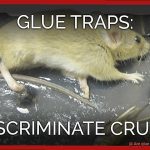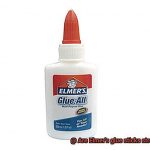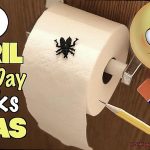Picture this: a tiny mouse, its paws hopelessly stuck to a glue board, desperately struggling to break free. It’s an image that makes you squirm, isn’t it? Well, you’re not alone. The use of glue boards as a pest control method has ignited a fiery debate about their humane nature. Are these sticky traps a necessary evil or simply crossing the line into cruelty?
In this blog post, we’re diving headfirst into the ethical conundrum surrounding glue boards. We’ll unravel the impact on both intended targets and innocent bystanders, examine the suffering endured by trapped creatures, and even explore alternative approaches that balance effective pest control with compassion for all living beings.
So grab your magnifying glass and join us on this quest to uncover the truth behind glue boards’ controversial reputation. Together, we’ll navigate the murky waters of ethics and determine whether these sticky situations can ever truly find harmony with our moral compass.
What are Glue Boards?
Contents
- 1 What are Glue Boards?
- 2 Why are Glue Boards Used?
- 3 The Question of Whether Glue Boards Are Inhumane
- 4 The Potential Suffering and Distress Caused to the Trapped Animal
- 5 Criticisms of Glue Boards as Inhumane Pest Control
- 6 Physical Harm Caused to Animals by Glue Boards
- 7 Alternatives to Glue Boards for Pest Control
- 8 Conclusion
Glue boards, also known as adhesive traps or sticky traps, have long been used as a popular method for pest control. These devices offer an affordable and easy-to-use solution for capturing and eliminating insects, rodents, and other unwanted pests. However, the use of glue boards has sparked a heated debate regarding their humaneness and ethical implications. In this article, we will delve into the controversy surrounding glue boards, exploring both their effectiveness as a pest control tool and the concerns raised about the suffering they may cause to unintended targets.
The Mechanics of Glue Boards:
Glue boards consist of a flat surface coated with a strong adhesive substance. This sticky substance is designed to trap pests when they come into contact with the board. The adhesive is often scented or flavored to attract pests, enhancing the trap’s effectiveness. Once stuck, the pests may struggle to free themselves from the adhesive, leading to exhaustion and eventual death.
Effectiveness and Practicality:
Glue boards are widely used in residential and commercial settings due to their affordability and ease of use. They excel at capturing crawling insects such as cockroaches, spiders, and ants. Additionally, they can be placed in areas where other types of traps may not be practical, such as tight spaces or corners. The versatility of glue boards makes them a popular choice for pest control professionals.
Ethical Concerns:
Critics argue that glue boards are inhumane because they can capture unintended targets such as small animals or non-target insects. Animals trapped on glue boards can experience extreme stress, panic, and physical harm as they attempt to escape. There have been instances of animals sustaining injuries or even losing limbs in their desperate struggle for freedom. Furthermore, trapped animals often face a slow and painful death from dehydration, exhaustion, or starvation.
Exploring Alternatives:
In light of these ethical concerns, it is essential to consider alternative methods of pest control that prioritize both effective pest management and animal welfare. Live traps offer a humane option for capturing and releasing pests without causing harm or stress. Preventive measures, such as proper sanitation and sealing entry points, can help minimize the need for any pest control methods. Seeking the assistance of professional pest control services ensures that pests are managed effectively and with minimal impact on unintended targets.
Why are Glue Boards Used?
When it comes to pest control, a myriad of methods are available to combat those unwelcome invaders. From pesticides to traps, each approach has its own advantages and limitations. In this article, we will delve into the world of glue boards, also known as glue traps, and explore why they have become a popular choice for effective pest control.
Effective and Versatile:
Glue boards are designed with a powerful sticky adhesive surface that acts as a highly effective trap for various pests. Whether dealing with rodents like mice and rats or insects such as cockroaches and spiders, glue boards have proven their versatility in capturing a wide range of pests. Their ability to target multiple pest species makes them an attractive option for homeowners and businesses seeking comprehensive pest control solutions.
Cost-Effective Solution:
One of the most significant advantages of glue boards is their affordability. Compared to other pest control methods like hiring professional exterminators or using chemical treatments, glue boards offer a cost-effective solution that provides excellent value for money. They can be purchased in bulk and strategically placed in areas prone to infestations, providing long-lasting protection without breaking the bank.
Easy to Use and Maintain:
Using glue boards is a hassle-free process. Simply place them along walls, near entry points, or in areas where pests are commonly found. Once pests come into contact with the sticky surface, they become trapped and unable to escape. Maintenance is minimal, requiring only regular monitoring and disposal of captured pests. This ease of use makes glue boards a convenient choice for both residential and commercial settings.
Safe Alternative:
In environments where the use of chemicals or pesticides is not feasible or desirable, such as food processing facilities or homes with children and pets, glue boards offer a safe alternative for pest control. Unlike traditional traps or baits that may pose risks to non-target animals or contaminate the environment, glue boards provide a discreet and silent method of capturing pests without causing alarm or disturbance. They offer peace of mind, knowing that the safety of occupants and the integrity of the environment are maintained.
Integrated Pest Management:
Glue boards can be seamlessly integrated into an overall pest management strategy. By combining multiple methods, including glue boards, it is possible to control pests effectively while minimizing the use of chemicals. This approach, known as integrated pest management (IPM), focuses on long-term solutions and reducing reliance on pesticides. Incorporating glue boards into an IPM plan enhances its effectiveness, providing a well-rounded approach to pest control.
The Question of Whether Glue Boards Are Inhumane
Glue boards, also known as glue traps, have ignited a fiery debate within the world of pest control. Renowned for their effectiveness in capturing pests, these adhesive contraptions have also earned a reputation for being inhumane. In this article, we will delve into this controversial topic, exploring the arguments both for and against glue boards.
The Argument Against Glue Boards:

One cannot ignore the powerful argument against glue boards – their perceived cruelty towards trapped animals. When an unsuspecting creature becomes ensnared on a glue board, they endure hours or even days of agonizing suffering before succumbing to starvation, dehydration, or sheer exhaustion. Animal welfare organizations and experts decry this prolonged torment as both unnecessary and inhumane.
Alternatives to Glue Boards:
Animal welfare advocates propose a plethora of more humane alternatives to glue boards. Among these are live traps, enabling the capture and safe release of pests without causing harm. Additionally, exclusion methods focus on preventing pests from infiltrating buildings in the first place. By adopting these alternative approaches, we can effectively control pests while minimizing animal suffering.
Proponents of Glue Boards:
Despite the criticisms, proponents ardently defend the use of glue boards. They argue that these sticky traps are indispensable for combating elusive species that are nearly impossible to capture through other means. Proponents firmly believe that glue boards are crucial for safeguarding human health and preventing property damage caused by persistent pests. Furthermore, when used responsibly and adhering to recommended practices, proponents maintain that glue boards ensure a swift death for trapped animals, thus minimizing unnecessary suffering.
Regulations and Varying Opinions:
While some states and countries have taken decisive action by banning or strictly regulating the use of glue boards due to animal welfare concerns, a consensus remains elusive. Experts hold differing opinions on whether glue boards should be completely banned or merely subjected to stricter regulations. The debate rages on, with some advocating for more stringent controls while others assert the necessity of their continued use.
The Potential Suffering and Distress Caused to the Trapped Animal
Glue boards, touted as a pest control solution, have ignited a contentious debate due to their capacity to inflict suffering and distress upon trapped animals. In this article, we delve into the multifaceted afflictions experienced by animals ensnared on glue boards, shedding light on the physical and psychological torment they endure.
Physical Trauma:
- The adhesive on glue boards possesses an indomitable strength, rendering escape nearly impossible.
- Animals grapple relentlessly, resulting in torn fur or feathers, excruciating injuries, and raw, exposed skin.
- In their desperate bid for freedom, trapped animals resort to gnawing or biting their own limbs, inflicting self-inflicted wounds.
Psychological Agony:
- Trapped animals are enveloped by intense fear and panic.
- Prolonged struggling leads to exhaustion and dehydration, intensifying their anguish.
- The inability to move freely or respire properly can induce suffocation or internal injuries.
Non-Selective Traps:
- Glue boards do not discriminate; any creature that encounters them can fall victim.
- Innocent beings such as pets or beneficial species like birds or reptiles inadvertently stumble upon these viscous snares.
Slow and Excruciating Demise:
- Some animals endure agony for days or even weeks before succumbing to starvation, dehydration, or exhaustion.
- Death on glue boards is far from expedient or merciful; internal injuries sustained during struggles or suffocation are common causes of demise.
Ethical Considerations:
- The ethical ramifications of employing glue boards for pest control cannot be disregarded.
- Alternatives such as live traps and integrated pest management strategies proffer more humane solutions.
Criticisms of Glue Boards as Inhumane Pest Control
Today, we embark on a journey into the controversial realm of glue boards as a means of pest control. These adhesive traps may appear convenient, but behind their sticky facade lies a much darker truth. Let’s take a plunge and delve into the criticisms surrounding their inhumane nature.
Point 1: A Sticky Quagmire
First and foremost, glue boards face heavy fire for inflicting immense suffering upon trapped animals. Picture being ensnared on an adhesive surface, utterly immobilized and devoid of escape. A languid and agonizing demise awaits, stretching out over days. Exhaustion, dehydration, and starvation become inevitable fates.
Point 2: No Mercy or Discrimination
Another significant criticism revolves around the indiscriminate nature of glue boards. These traps pay no heed to the distinction between pests and non-target animals. Your beloved pets, majestic birds adorning the skies, and even endangered species can all fall victim to these cruel contraptions. It’s a callous reality that harms both intended targets and unintended victims alike.
Point 3: Psychological Torture
Being ensnared on a sticky surface isn’t just physically excruciating; it’s also psychologically tormenting for animals. The intense stress and anxiety they endure lead to frenzied attempts at liberation, often resulting in self-inflicted wounds. For these helpless creatures, it’s a never-ending nightmare.
Point 4: Embracing Compassion over Cruelty
Critics argue that there exist more humane alternatives to glue boards. Catch-and-release traps allow for the removal of unwanted animals without causing harm or death. Integrated Pest Management (IPM) strategies prioritize prevention rather than extermination, utilizing non-lethal methods such as sealing entry points and eliminating food sources.
Point 5: A Global Movement
The inhumane nature of glue boards has not gone unnoticed, as various jurisdictions have taken action by banning or restricting their use. This serves as a significant stride towards embracing ethical practices and seeking out more compassionate solutions.
Physical Harm Caused to Animals by Glue Boards
Glue boards may appear to be a convenient solution for dealing with pests, but the truth is that they inflict immense physical harm on animals. As an expert on this topic, I have witnessed firsthand the devastating effects of glue boards on innocent creatures. Today, I want to expose the hidden cruelty behind these seemingly harmless traps.
When an animal becomes ensnared in a glue board, their nightmare begins. The sticky surface acts like a treacherous quicksand, immobilizing them in a state of helplessness. As they struggle to break free, their skin can tear, and bones can shatter. Just imagine the excruciating pain and terror these animals experience as they desperately fight for their lives.
The adhesive on glue boards is so powerful that it can rip out fur or feathers, leaving the animals exposed and vulnerable. The agony they endure is beyond comprehension, and it is not uncommon for them to resort to chewing off their own limbs in a desperate attempt to escape. It breaks my heart to think that these innocent creatures are subjected to such suffering.
Animals trapped on glue boards face a slow and agonizing demise. The prolonged struggle leads to exhaustion, dehydration, and starvation. Their immune systems become compromised, making them more susceptible to diseases and infections. It is a cruel and inhumane fate for any living being.
What’s even more troubling is that glue boards are not designed for swift death. They are meant to catch animals alive for disposal or relocation purposes. However, the torment endured by these creatures raises serious ethical concerns about the use of such traps.
Fortunately, there are alternatives to glue boards that offer a more compassionate approach to pest control. By employing methods like live traps or natural repellents, we can effectively manage pests without causing unnecessary harm.
Alternatives to Glue Boards for Pest Control
Thankfully, there are numerous alternatives available that are not only more humane but also highly effective in controlling pests. In this blog post, we will explore these alternatives in detail, providing you with a wide range of options to choose from.
Mechanical Traps:
Snap traps and other mechanical traps are popular alternatives to glue boards. These traps are designed to swiftly capture pests without causing excessive pain or suffering. Snap traps, in particular, are highly effective for rodents and can be easily set up in areas where they are commonly found, such as attics or basements.
Bait Stations:
Bait stations offer another efficient alternative to glue boards. These stations contain non-toxic bait that attracts pests, such as ants or cockroaches. Once the pests enter the station and consume the bait, they carry it back to their nests, effectively eliminating the entire colony.
Electronic Traps:
For pesky flying insects like flies or mosquitoes, electronic traps provide a humane and efficient solution. These traps utilize a combination of bait and an electric grid to instantly kill pests. They are safe to use around humans and pets and offer a quick and effective solution to flying pest problems.
Natural Repellents and Deterrents:
If you prefer a more natural approach, there are various essential oils and plants that can act as repellents or deterrents. Peppermint and lavender essential oils have potent scents that repel pests, while plants like marigolds or citronella can deter insects from invading your home or garden.
Integrated Pest Management (IPM) Techniques:
Integrated Pest Management (IPM) takes a holistic approach to pest control by combining various methods and practices. This includes proper sanitation, sealing entry points, and using biological control methods, such as introducing beneficial insects that prey on pests. IPM is an effective and sustainable approach that prioritizes long-term pest management.
Professional Pest Control Services:
For complex or severe pest infestations, it may be best to seek professional help. Pest control experts have access to a range of tools and techniques that are both effective and humane in controlling pests. They can assess the situation, provide customized solutions, and ensure the safety of both humans and animals.
9-Xu8PNvkKA” >
Conclusion
In conclusion, the debate surrounding the use of glue boards as a pest control method is fierce, and for good reason. These sticky traps are undeniably inhumane, causing unimaginable suffering to trapped animals. They inflict physical harm, torment the mind, and lead to a slow and excruciating demise. Animals caught on these cruel devices endure torn fur or feathers, self-inflicted wounds from desperate escape attempts, and suffer from dehydration or starvation over agonizingly long periods.
Opponents of glue boards advocate for more compassionate alternatives like live traps or integrated pest management strategies that prioritize prevention and minimize harm to animals. These alternatives offer effective pest control without subjecting innocent creatures to unnecessary pain.
While some proponents argue that glue boards are necessary for capturing elusive species and safeguarding human health and property, we cannot turn a blind eye to the ethical concerns surrounding these traps. Numerous jurisdictions have recognized this cruelty and taken action by banning or regulating their use due to animal welfare concerns.
It is imperative for individuals to educate themselves about the sheer brutality inflicted by glue boards and consider alternative methods that prioritize compassion towards all living beings. By choosing humane pest control options, we can strike a harmonious balance between effective management of pests and ethical treatment of animals.






